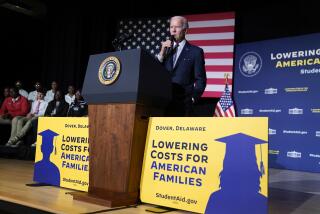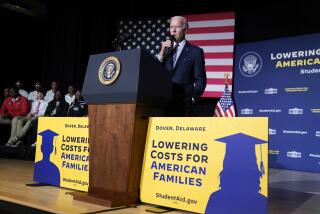Here’s how to ease the load of student loans

High school seniors are wrapping up their last year — studying for finals, battling senioritis and mailing out graduation announcements. And while those destined for college are beginning to receive financial aid award letters, student loan debt probably isn’t top of mind.
But maybe it should be.
A 2019 high school graduate who will depend on student loans for college can expect to borrow $37,400, on average, in pursuit of a bachelor’s degree, according to a NerdWallet analysis. That total assumes that a bachelor’s degree will take an average of about five years to complete, based on National Student Clearinghouse data.
An estimated 1.3 million of the nation’s high school graduates — 44% of them — will enroll in four-year colleges or universities. Of those, half are expected to take on student loan debt, according to NerdWallet’s analysis of National Center for Education Statistics data.
This loan total is a conservative estimate, because our projections were limited to public colleges and universities, not private institutions where loan amounts and award rates tend to be higher. The math assumes the average loan amount per student will continue growing at a relatively slow pace, a trend seen in the latest available data.
“It’s encouraging to see that student loan growth is easing, but college debt is still a legitimate challenge for millions of people,” said Teddy Nykiel, NerdWallet’s student loan expert. “My advice to incoming college freshmen: Don’t borrow blindly. Student debt isn’t good debt if you don’t earn enough to repay it without straining your finances.”
Entering college with future debt hanging over your head can make it hard to focus on studying, let alone enjoying the experience. Here are tips for students and parents to make education loans more manageable before, during and after college.
Exhaust all other reasonable funding sources
Loans are the most expensive way to pay for college. Other ways to lighten the load include grants and federal work-study, with eligibility determined annually. Plan to submit the Free Application for Federal Student Aid, known as the FAFSA, every year you’re in school.
Those attending school in fall 2019 should submit their FAFSA as soon as possible if they haven’t already, as state and institutional deadlines may have passed. Check with the financial aid office to be sure. For the 2019-20 school year, the official FAFSA deadline is June 30, 2020, to allow for students attending classes next summer. You’ll be eligible again for financial aid based on new income numbers when applications open in October for the following fall term.
Keep in mind, scholarships from colleges and organizations are available after freshman year, as well. Lighten your overall debt load by keeping an eye out and applying for these sources of funding throughout the year, every year, not just as you prepare for your first semester.
Parents: Don’t sacrifice retirement savings
It can be tempting for parents to want to help reduce their child’s student loan debt by tapping into retirement savings. But depleting your retirement fund will only put you in a bind down the road. Unless your ideal retirement is asking your college-educated child to help with your living costs, keep on saving.
“Your child can borrow for college, but you can’t borrow for retirement,” Nykiel said.
Borrow only what you need
You don’t have to accept all of the loans offered. Every dollar you accept increases the total debt and monthly payment you’ll be saddled with after graduation. Work with the school’s financial aid office to determine precisely how much you’ll need all-in — including tuition, fees, books, housing, a meal plan, on-campus parking fees and other costs. Find the difference between this total and what you expect to cover with cash, scholarships, grants and other sources, and accept loans only for what’s outstanding.
As a rule of thumb, aim to limit borrowing so future monthly payments aren’t more than 10% of your estimated future income. A student loan affordability calculator can help you gauge an appropriate amount of debt to take on.
Make payments during school to save on interest
For unsubsidized federal student loans, parent PLUS loans and private loans, interest accrues while you’re in school. Because of this interest, any amount you can put toward your debt while in school will lessen the amount you ultimately pay.
Maintain an edge by making monthly interest payments, if possible. Depending on your loan balance and interest rate, these payments could be less than the cost of a night on the town.
Choose the right repayment plan before you graduate
When college graduation is on the horizon, it’s time to start thinking about repayment. That $37,400 in projected student loans is a lot. Currently, undergraduates typically can borrow a total of $31,000. Anything more will be in the form of parent loans or private loans with a co-signer.
Fortunately, $31,000 represents a good portion of the total projected debt, and the federal government offers a few repayment options to make getting out from under school loans more manageable.
Borrowers will be automatically funneled into a standard 10-year repayment plan. That’s not a bad option if you can handle the payments. You’ll generally pay your debt off in a shorter time frame, which means you’ll save on interest and pay less overall.
Income-driven repayment options can have lower payments. They’re capped at 10% to 20% of discretionary income — payments can be as low as $0 — and your remaining balance can be forgiven after 20 to 25 years. The catch with income-driven plans: Interest keeps mounting even when payments are reduced, which means your balance could increase. And any amount forgiven is taxed as income.
“Income-driven repayment is a tool for people who can’t afford payments on the standard repayment plan or for those pursuing Public Service Loan Forgiveness,” Nykiel said. “It’s better than defaulting or putting loans in forbearance, but skip it if you can afford to.”
If any of your loans come from private lenders, contact your lender directly to see what options are available. Refinancing at a lower interest rate may be an option if your credit has improved since you first took out the loans.
“For high school graduates, repaying student loans may feel impossibly far away right now,” Nykiel said. “But their future selves will be thankful if they limit debt now.”
Elizabeth Renter is a writer at NerdWallet, a personal finance website.
More to Read
Inside the business of entertainment
The Wide Shot brings you news, analysis and insights on everything from streaming wars to production — and what it all means for the future.
You may occasionally receive promotional content from the Los Angeles Times.










